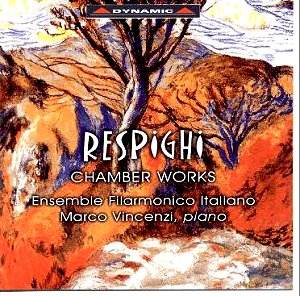Once again we are indebted to Dynamic for a third album
of Respighi chamber works. The Ensemble Filarmonico Italiano perform
chamber works composed by the young Respighi between the years 1897
and 1910. Those whose ears are attuned to the more exotic, richly coloured
works, like the Roman trilogy, will find these pieces something of a
shock for they nod towards the sound world of Brahms and Schumann rather
than Debussy or Rimsky-Korsakov.
The Piano Quintet in F minor is reminiscent of Brahms’
Quintet Op. 34. Marco Vincenzi and the Emsemble Filarmonico Italiano
capture the robust extrovert nature of the opening melodic Allegro
in a strong and rapturous reading. The short, very short (2’36”) Andantino
is light material echoing Schumann’s piano polyphony and Dvořák’s
quartet writing. The concluding Vivacissimo lives up to its appellation,
it is a moto perpetuo of triplets and quadruplets and a swirling
coda. All told, a striking virtuoso performance from the Italian players.
The theme of the Adagio con variazioni in B
Major for cello and piano is by Antonio Certani, a cellist from Bologna,
friend of Respighi and dedicatee of the work. Later in 1921 Respighi
would transpose the work for cello and orchestra. The theme juxtaposes
a melancholy melody for the cello over solemn marching figures on the
piano. There follows a set of variations with the cello variously determinedly
emphatic, nostalgic, and regretful with the piano in contrasting moods
sometimes spinning arpeggios, sometimes playfully introspective and
at one point hinting at Gregorian modes.
The Sonata in D minor for violin and piano is agreeably
melodic. It sings. It is clearly influenced by the German Romantics
although I was sometimes reminded of Elgar’s miniatures, for the first
movement has the hallmarks of salon music - much of the music is heartfelt
and sentimentally nostalgic. The Adagio continues much in the same mood.
It is sweetly doleful. The concluding Scherzo with its alternation of
dreamy expressiveness and ambiguous overlaps (almost Scottish-style)
is again reminiscent of Brahms. The work is performed very sympathetically
with no hint of condescension to its sweetness.
The Melodia in E major for violin and piano has the
aura of salon music again but this time the influence is Italian opera.
Finally comes the earliest work, the Sonata in F minor
for piano of 1897 written when Respighi was in his late teens. It is
somewhat self-conscious and not too successful a mélange that
echoes not only Brahms and Schumann but also Mendelssohn, Slavonic echoes
and maybe even something of Scriabin as Marco Vincenzi (the very able
pianist on this recording) hints in his erudite notes for this album.
The more straight-forward Lento central movement convinces most.
A valuable addition to the catalogue of accessible,
melodic, sympathetically performed chamber works by the young Respighi.
Ian Lace


